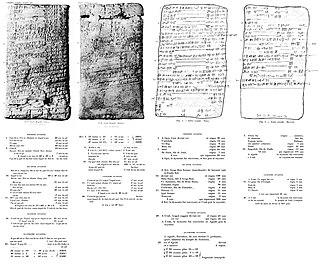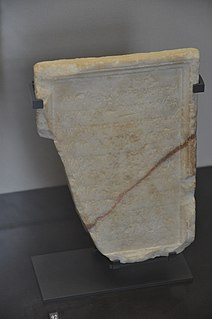Ferentina was the patron goddess of the city Ferentinum, Latium. She was protector of the Latin commonwealth. She was also closely associated with the Roman Empire.
Paolo Matthiae is an Italian archaeologist.

Jean-Jacques Barthélemy was a French scholar who became the first person to decipher an extinct language. He deciphered the Palmyrene alphabet in 1754 and the Phoenician alphabet in 1758.
Louis Robert was a professor of Greek history and Epigraphy at the Collège de France, and author of many volumes and articles on Greek epigraphy, numismatics, and the historical geography of Greek lands. Robert studied at the École Normale Supérieure from 1924 to 1927, was a member of the École française d'Athènes from 1927 to 1932, and taught at the École pratique des hautes études in Paris from 1932. He was made full professor at the Collège de France in 1939, where he remained until his retirement in 1974. He continued to publish on Greek epigraphy with his wife, Jeanne Robert, as co-author, as he had done since their marriage and until his death in 1985.
André Dupont-Sommer was a French semitologist. He specialized in the history of Judaism around the beginning of the Common Era, and especially the Dead Sea Scrolls. He was a graduate of the Sorbonne and he taught at various institutions in France including the Collége de France (1963–1971) where he held the chair of Hebrew and Aramaic.
The Prix Stanislas Julien is a prize for a sinological work (usually) published in the previous year. It is named after the French sinologist, Stanislas Julien, and is awarded by the Académie des Inscriptions et Belles-Lettres. The prize was established in 1872 and first awarded in 1875.

The Scheil dynastic tablet is an ancient Mesopotamian cuneiform text containing a variant form of the Sumerian King List.
Aspbed, was a title of Iranian origin used by the Parthian and Sasanian empires.

The Libyco-Punic Mausoleum of Dougga is an ancient mausoleum located in Dougga, Tunisia. It is one of three examples of the royal architecture of Numidia, which is in a good state of preservation and dates to the 2nd century BC. It was restored by the government of French Tunisia between 1908-10.

André Laronde was a French hellenist archaeologist.
William Seston was a 20th-century French historian and epigrapher, a specialist of the history of the Roman Empire. He was professor at the Sorbonne and a member of the Académie des Inscriptions et Belles-Lettres.
The Prix Giles is awarded biennially for a work related to China, Japan or East Asia that was published in the previous two years by a French author. It is named after the British sinologist Herbert Giles, and is awarded by the Académie des Inscriptions et Belles-Lettres. The prize was established in 1917 and was funded by Herbert Giles himself. The first award was given in 1919.

The Yehawmilk stele, de Clercq stele, or Byblos stele, also known as KAI 10 and CIS I 1, is a Phoenician inscription from c.450 BC found in Byblos at the end of Ernest Renan's Mission de Phénicie. Yehawmilk, king of Byblos, dedicated the stele to the city’s protective goddess Ba'alat Gebal.

The Neirab steles are two 8th-century BC steles with Aramaic inscriptions found in 1891 in Al-Nayrab near Aleppo, Syria. They are currently in the Louvre. They were discovered in 1891 and acquired by Charles Simon Clermont-Ganneau for the Louvre on behalf of the Commission of the Corpus Inscriptionum Semiticarum. The steles are made of black basalt, and the inscriptions note that they were funerary steles. The inscriptions are known as KAI 225 and KAI 226.

The Punic Tabella Defixionis is a Punic language curse tablet, inscribed on a lead scroll, found in Carthage by Paul Gauckler in 1899. It is currently held at the Carthage National Museum. It is known as KAI 89.

The Avignon Punic inscription is a Punic language inscription found in the Champfleury area of Quartier Ouest of Avignon in 1897, by a builder digging a trench 2-3 meters deep on the boundary of a property. It was first announced by Mayer Lambert.
The Prix Bordin is a series of prizes awarded annually by each of the five institutions making up the Institut Français since 1835.

The Cherchell Neopunic inscriptions are two Neopunic inscriptions on marble discovered in 1875 and 1882 in Cherchell in French Algeria. They are currently in the Louvre.

The Abdmiskar cippus is a white marble cippus in obelisk form discovered in Sidon, Lebanon, dated to 300 BCE. Discovered in 1890 by Joseph-Ange Durighello.

The Abiba’l Inscription is a Phoenician inscription from Byblos on the base of a throne on which a statue of Sheshonq I was placed. It is held at the Vorderasiatisches Museum Berlin.















